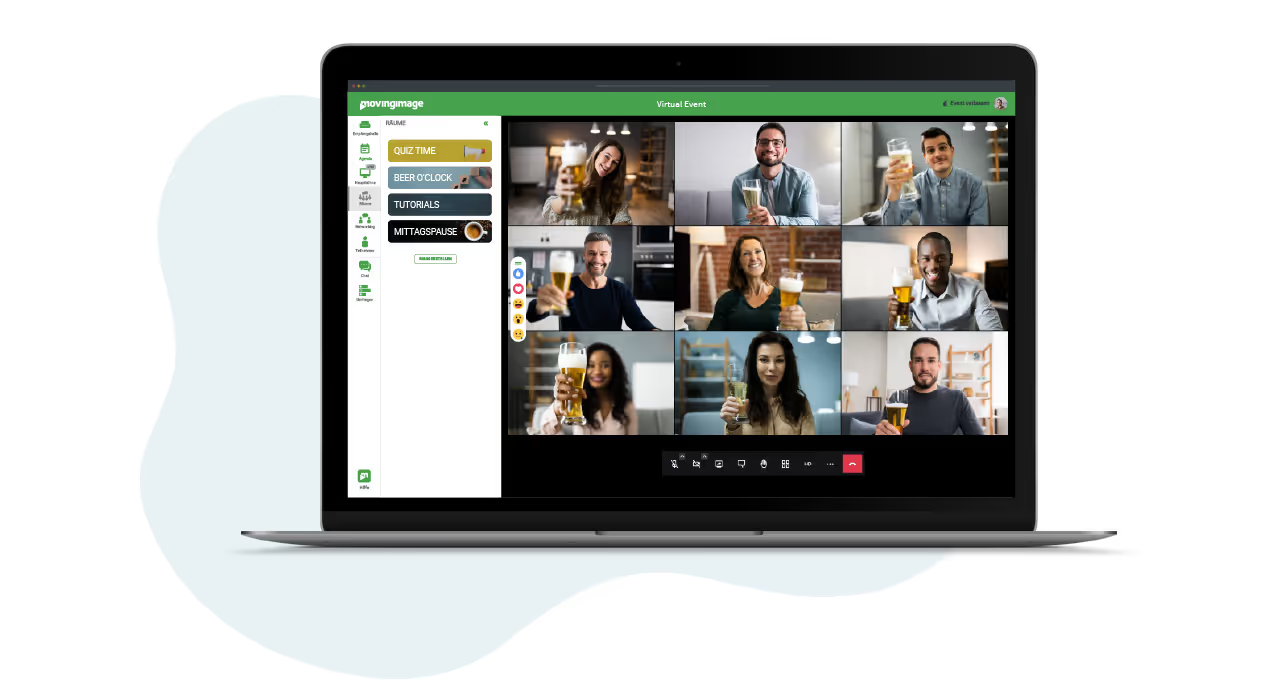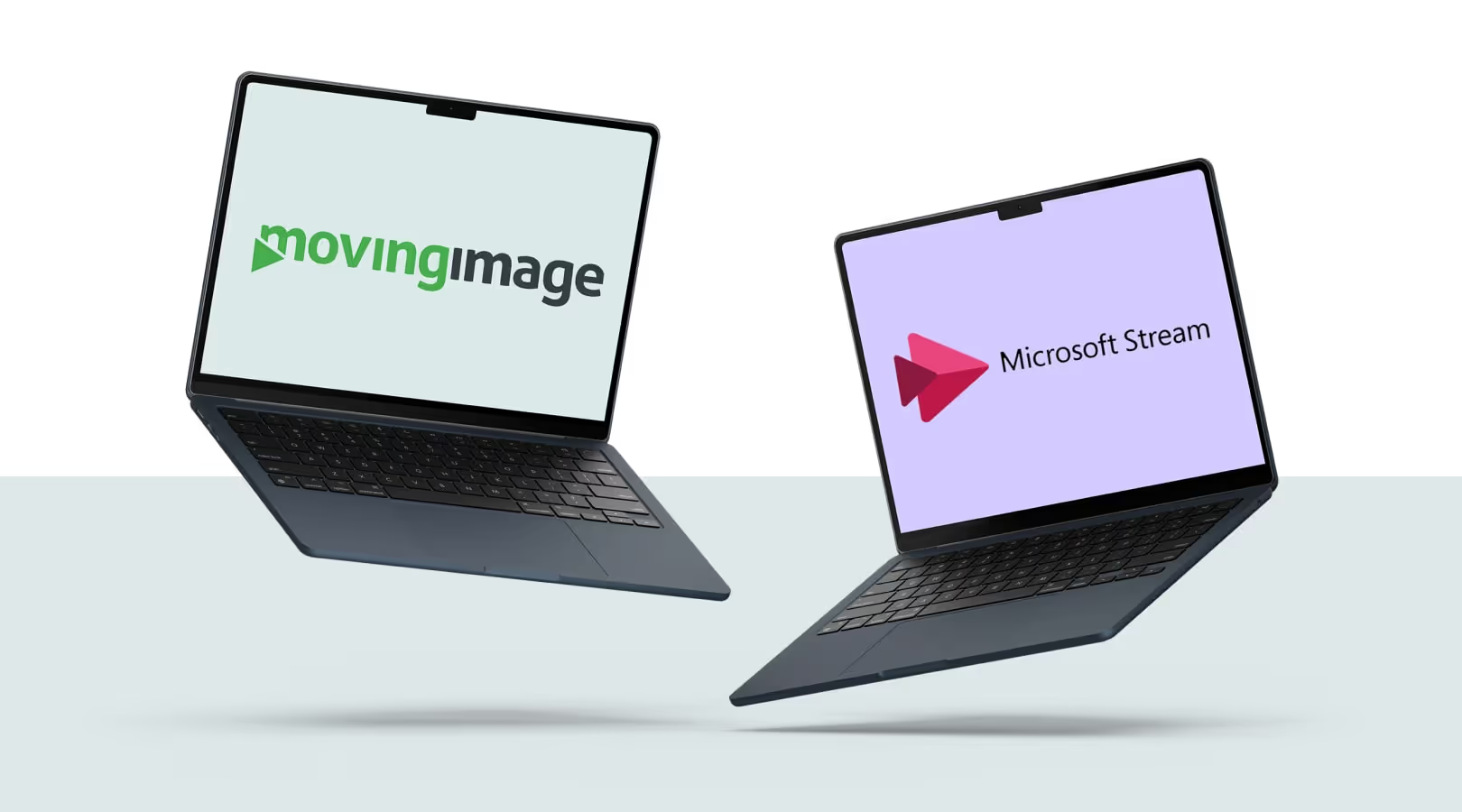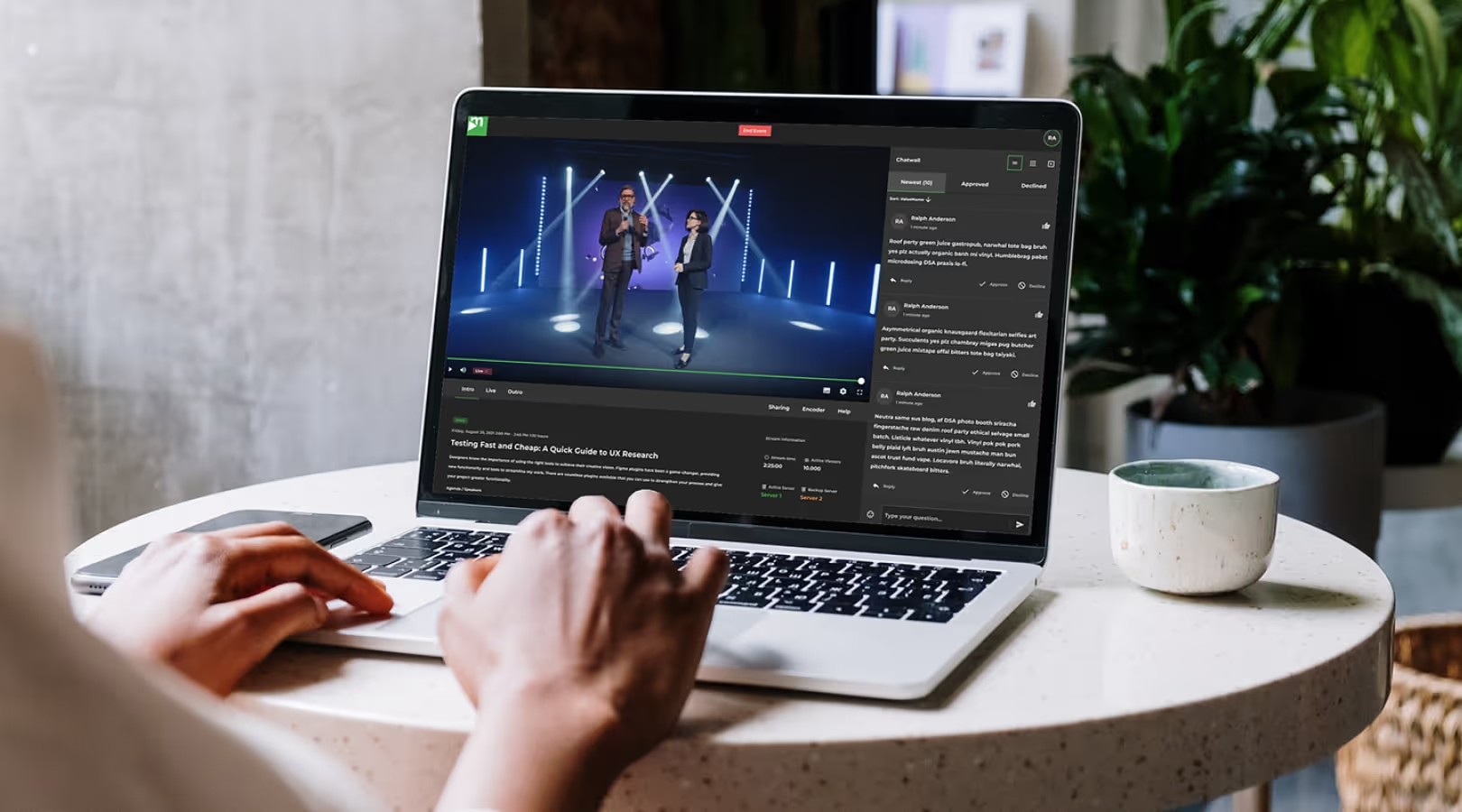How to make virtual team events a success

Driving your success with video

How to make virtual team events a success
At the beginning of 2020, many companies had little choice but to cancel their planned internal and external events—or move them entirely online due to the pandemic. What started as a stopgap solution has since become a firmly established part of corporate life.
As a result of digital transformation projects and strategies aligned with the “New Work” movement, video communication continues to play a key role in day-to-day business. However, by summer 2021, surveys began to reveal growing video fatigue among employees.
To make a virtual team event as impactful and memorable as an in-person gathering, companies need to create the right framework and provide the right incentives.
Highlight sustainability – and benefit from its advantages
When employees look back fondly on a company event, it's usually thanks to a great buffet, engaging conversations, reconnecting with colleagues they haven’t seen in a while, or an entertaining program. What they definitely don’t remember fondly is the long and unproductive commute.
And that’s precisely where virtual events can shine. Too often, invitations to online events make them sound like second-class alternatives—especially when they emphasize how much better it would have been to meet in person. But who wants to be a “second choice”?
Of course, it’s fine to mention that the virtual format was chosen with health and safety in mind. But those aren’t the only benefits. Digital events eliminate the need for long-distance travel, reduce emissions, and are better for the environment. Employees save time—and are, quite literally, already back home.
So if you decide to explain your choice of format, it's better to emphasize sustainability and flexibility as your reasons.
Virtual team events as a bridge: how hybrid formats bring teams together
A hybrid format can be a great alternative to a fully virtual event. There are many creative variations that help give the event its own unique atmosphere.
For example, you might host a panel discussion with in-person participants. Or stream a live keynote followed by a Q&A session, where the moderator collects questions from both the live audience and remote attendees.
Even simple approaches like these can create an entirely different experience than the one people associate with typical video conferences.
The right software is reliable—and enables interaction

To make your event a success and a true experience, your software solution shouldn’t limit your creative options. Standard video conferencing tools aren’t ideal here. While they serve their purpose for quick check-ins among small groups, they quickly reach their limits when hundreds—or even thousands—of participants join.
A successful virtual event starts with a platform that’s purpose-built for this type of experience. Virtual Events is designed for high-quality streaming and stable connections. After all, nothing disrupts shared moments like laggy video or choppy audio due to platform limitations or poor compatibility with users’ devices.
Reliability and stability alone don’t guarantee a successful event—but they’re a critical foundation.
Whether hybrid or fully online, long-term engagement requires interactive elements. And just like any in-person event, casual conversations in small groups are part of what makes it special. Virtual Events offers a wide range of features that bring those real-world elements into the digital space:
- Participants can move freely between different “rooms”—from a main stage for 10,000+ attendees to smaller rooms with just four video feeds.
- A virtual lobby welcomes guests and provides information about the agenda, event structure, and featured speakers.
- In breakout rooms, participants can exchange ideas, network, or catch up in small groups.
- Live chat and polls offer additional ways to engage and interact throughout the event.
Strengthen team spirit: creative ideas that bring people together

A solid technical foundation is the perfect starting point for getting participants involved—while still giving them the freedom to connect in smaller groups. But to create a real sense of togetherness and lasting memories across different locations, all it takes is a little creativity.
- Dress code: Just because you’re not meeting in person doesn’t mean you can’t dress up for the camera. Encourage your team to wear what they’d normally wear to the office—or go for a coordinated look in branded company merch to spark a sense of unity. Want to add some humor? Try a theme like “ugliest sweater wins.” Depending on the season, you could also mail fun accessories to everyone in advance—Santa hats for Christmas or bunny ears for Easter. It’s a great way to lighten the mood.
- Music & entertainment: For hybrid events, how about a mini concert streamed live from a local band—or even better, from musically talented employees? Virtual concerts with solo performances are also possible, although a bit more technically demanding. Or keep it casual with a karaoke session. It might take some courage, but it could become the highlight everyone talks about for the next year. Whether it’s on YouTube or a karaoke app—no virtual party is complete without a ’90s playlist.
- Voting features are perfect for adding humor and playfulness. Try fun guessing games, polls, or light-hearted questions to set a relaxed tone. Gamification can go a long way in making your event memorable.
- Games: From Taboo to Mario Kart, there are plenty of board and video games that can be played online for free. Use your event platform’s breakout rooms to set up different “game rooms” so participants can choose what suits them best. Free tools like Kahoot! or Outgrow make it easy to create custom quizzes with a scoring system. Topics are limitless—from holiday trivia to inside jokes about company life. The more personal, the better! Virtual escape rooms have also made a comeback. Solve tricky puzzles together, find hidden clues, and discover unexpected sides of your colleagues. If your company has multiple teams, turn it into a friendly competition: first team to escape wins a prize.
- Goodie bags sent to everyone ahead of time can add to the excitement—especially if they’re opened step by step during the event.
- Workshops & tutorials: A cooking show, a mixology class, or a fitness session can all turn your virtual event into a real shared experience. They encourage informal conversation while giving participants something fun and active to do together.
Since you won’t be sharing a meal in person, consider giving each employee a meal budget so they can order from a local restaurant of their choice. It’s a small gesture that shows appreciation—and boosts morale and connection. Alternatively, send out a DIY cocktail kit or HelloFresh box so the team can cook or mix drinks together via video. Just be sure the ingredients and recipes arrive on time.
The event starts before the event
The positive impression of a company event doesn’t begin on the day itself. At in-person gatherings, people get into the spirit just by picking out their party outfit. A fun theme or friendly contest can build anticipation well in advance. Even the welcome area on-site helps set the mood. At a virtual event, none of this happens automatically—at least not in the same way.
That’s why it’s all the more important to plan your invitation and pre-event communication carefully. Let participants know what to expect: What’s on the agenda? What opportunities are there for informal chats in smaller groups? You can even send out the goodie bag along with the invite—just be sure to include a hint about what it’s for.
If you’re using a new platform or tool, include a short explainer covering the key features to help everyone feel at ease. After all, tech is just a means to an end—and no one enjoys an event if they’re lost in the virtual lobby.
Speaking of fun: a great company event should be fun. That’s a message worth including in the invitation, too.
Our Speakers
At the beginning of 2020, many companies had little choice but to cancel their planned internal and external events—or move them entirely online due to the pandemic. What started as a stopgap solution has since become a firmly established part of corporate life.
As a result of digital transformation projects and strategies aligned with the “New Work” movement, video communication continues to play a key role in day-to-day business. However, by summer 2021, surveys began to reveal growing video fatigue among employees.
To make a virtual team event as impactful and memorable as an in-person gathering, companies need to create the right framework and provide the right incentives.
Highlight sustainability – and benefit from its advantages
When employees look back fondly on a company event, it's usually thanks to a great buffet, engaging conversations, reconnecting with colleagues they haven’t seen in a while, or an entertaining program. What they definitely don’t remember fondly is the long and unproductive commute.
And that’s precisely where virtual events can shine. Too often, invitations to online events make them sound like second-class alternatives—especially when they emphasize how much better it would have been to meet in person. But who wants to be a “second choice”?
Of course, it’s fine to mention that the virtual format was chosen with health and safety in mind. But those aren’t the only benefits. Digital events eliminate the need for long-distance travel, reduce emissions, and are better for the environment. Employees save time—and are, quite literally, already back home.
So if you decide to explain your choice of format, it's better to emphasize sustainability and flexibility as your reasons.
Virtual team events as a bridge: how hybrid formats bring teams together
A hybrid format can be a great alternative to a fully virtual event. There are many creative variations that help give the event its own unique atmosphere.
For example, you might host a panel discussion with in-person participants. Or stream a live keynote followed by a Q&A session, where the moderator collects questions from both the live audience and remote attendees.
Even simple approaches like these can create an entirely different experience than the one people associate with typical video conferences.
The right software is reliable—and enables interaction

To make your event a success and a true experience, your software solution shouldn’t limit your creative options. Standard video conferencing tools aren’t ideal here. While they serve their purpose for quick check-ins among small groups, they quickly reach their limits when hundreds—or even thousands—of participants join.
A successful virtual event starts with a platform that’s purpose-built for this type of experience. Virtual Events is designed for high-quality streaming and stable connections. After all, nothing disrupts shared moments like laggy video or choppy audio due to platform limitations or poor compatibility with users’ devices.
Reliability and stability alone don’t guarantee a successful event—but they’re a critical foundation.
Whether hybrid or fully online, long-term engagement requires interactive elements. And just like any in-person event, casual conversations in small groups are part of what makes it special. Virtual Events offers a wide range of features that bring those real-world elements into the digital space:
- Participants can move freely between different “rooms”—from a main stage for 10,000+ attendees to smaller rooms with just four video feeds.
- A virtual lobby welcomes guests and provides information about the agenda, event structure, and featured speakers.
- In breakout rooms, participants can exchange ideas, network, or catch up in small groups.
- Live chat and polls offer additional ways to engage and interact throughout the event.
Strengthen team spirit: creative ideas that bring people together

A solid technical foundation is the perfect starting point for getting participants involved—while still giving them the freedom to connect in smaller groups. But to create a real sense of togetherness and lasting memories across different locations, all it takes is a little creativity.
- Dress code: Just because you’re not meeting in person doesn’t mean you can’t dress up for the camera. Encourage your team to wear what they’d normally wear to the office—or go for a coordinated look in branded company merch to spark a sense of unity. Want to add some humor? Try a theme like “ugliest sweater wins.” Depending on the season, you could also mail fun accessories to everyone in advance—Santa hats for Christmas or bunny ears for Easter. It’s a great way to lighten the mood.
- Music & entertainment: For hybrid events, how about a mini concert streamed live from a local band—or even better, from musically talented employees? Virtual concerts with solo performances are also possible, although a bit more technically demanding. Or keep it casual with a karaoke session. It might take some courage, but it could become the highlight everyone talks about for the next year. Whether it’s on YouTube or a karaoke app—no virtual party is complete without a ’90s playlist.
- Voting features are perfect for adding humor and playfulness. Try fun guessing games, polls, or light-hearted questions to set a relaxed tone. Gamification can go a long way in making your event memorable.
- Games: From Taboo to Mario Kart, there are plenty of board and video games that can be played online for free. Use your event platform’s breakout rooms to set up different “game rooms” so participants can choose what suits them best. Free tools like Kahoot! or Outgrow make it easy to create custom quizzes with a scoring system. Topics are limitless—from holiday trivia to inside jokes about company life. The more personal, the better! Virtual escape rooms have also made a comeback. Solve tricky puzzles together, find hidden clues, and discover unexpected sides of your colleagues. If your company has multiple teams, turn it into a friendly competition: first team to escape wins a prize.
- Goodie bags sent to everyone ahead of time can add to the excitement—especially if they’re opened step by step during the event.
- Workshops & tutorials: A cooking show, a mixology class, or a fitness session can all turn your virtual event into a real shared experience. They encourage informal conversation while giving participants something fun and active to do together.
Since you won’t be sharing a meal in person, consider giving each employee a meal budget so they can order from a local restaurant of their choice. It’s a small gesture that shows appreciation—and boosts morale and connection. Alternatively, send out a DIY cocktail kit or HelloFresh box so the team can cook or mix drinks together via video. Just be sure the ingredients and recipes arrive on time.
The event starts before the event
The positive impression of a company event doesn’t begin on the day itself. At in-person gatherings, people get into the spirit just by picking out their party outfit. A fun theme or friendly contest can build anticipation well in advance. Even the welcome area on-site helps set the mood. At a virtual event, none of this happens automatically—at least not in the same way.
That’s why it’s all the more important to plan your invitation and pre-event communication carefully. Let participants know what to expect: What’s on the agenda? What opportunities are there for informal chats in smaller groups? You can even send out the goodie bag along with the invite—just be sure to include a hint about what it’s for.
If you’re using a new platform or tool, include a short explainer covering the key features to help everyone feel at ease. After all, tech is just a means to an end—and no one enjoys an event if they’re lost in the virtual lobby.
Speaking of fun: a great company event should be fun. That’s a message worth including in the invitation, too.



.avif)


.avif)






.avif)





